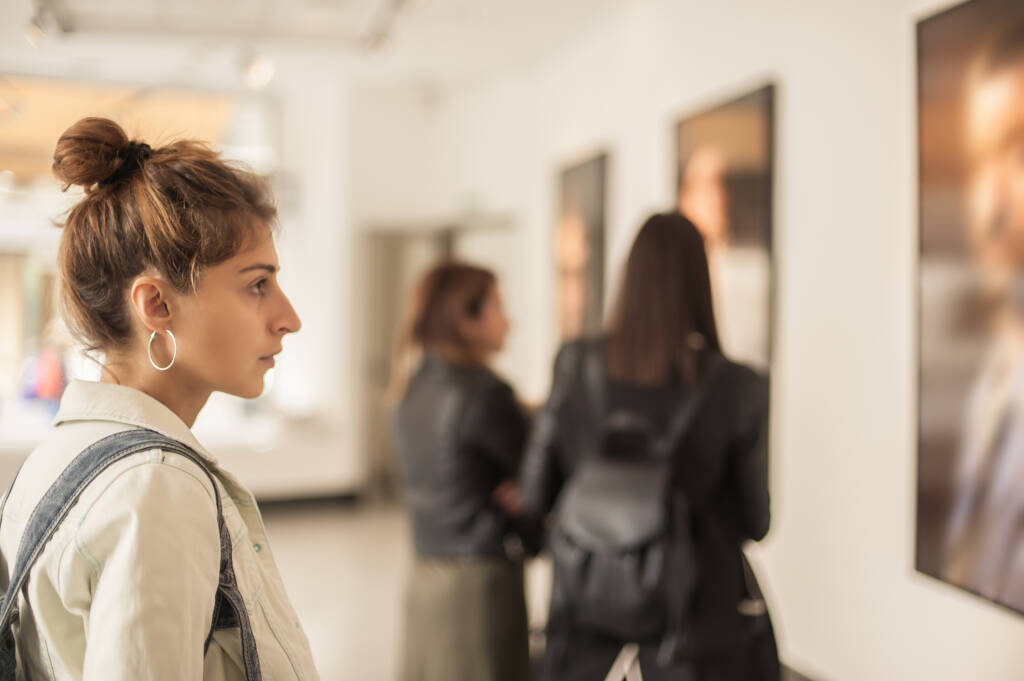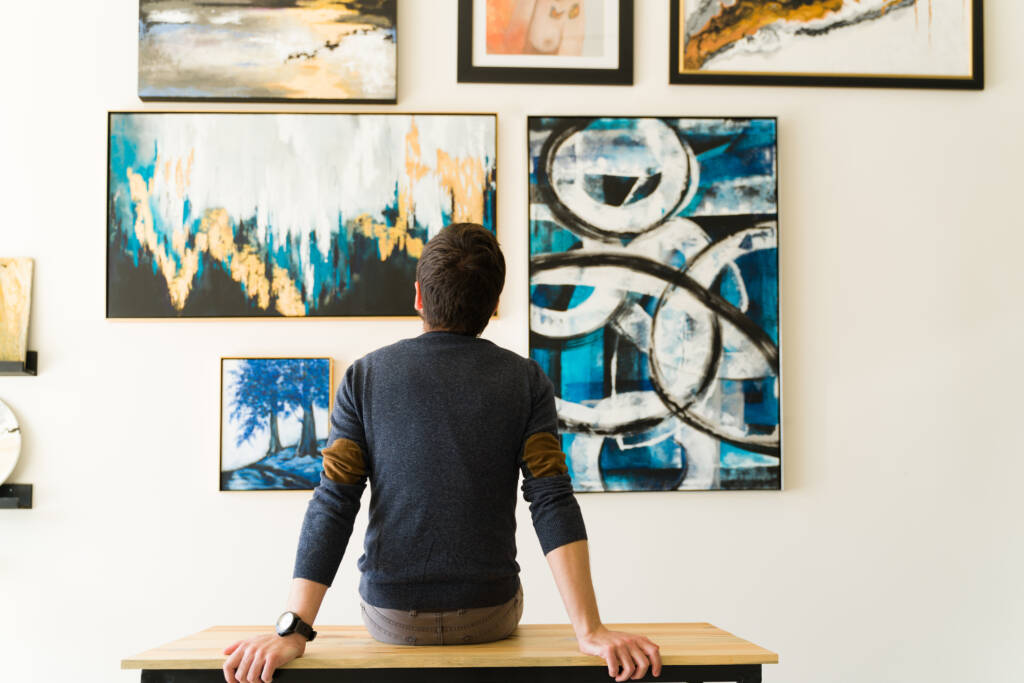
AP Art History

Within AP Art History, students will explore the interconnections between art, culture, and historical context using critical analysis through the critical lenses of artistic expression, cultural awareness, and purpose. Using a defined art historical skill set and reflective learning, students will analyze relationships across cultures with a global lens. The examination of how people have responded to and communicated their experiences through art will enable students to think conceptually about art ranging from prehistoric to contemporary. Students will be active participants, engaging with art and its context as they read, research, and collaborate to learn about art, artists, art making, and responses to and interpretations of art.
Major Topics and Concepts
Segment 1
Gallery One—Introduction to Art History
- An overview of art history and the purpose and function of the analysis of art within its cultural context
- Global and chronological themes and subthemes in art history
- An introduction to the College Board Advanced Placement Art History Framework
- Formal analysis of the art process through the principles and elements of design
- The College Board AP Art History Exam breakdown—what to expect, type of assessments on the exam, how the exam assesses the students’ application of art historical skills, and how the exam is scored
- Understanding how to read and interpret architectural plans
- Global Prehistory starting with Asia and Africa
- Paleolithic, Mesolithic, and Neolithic Periods
- Human expression of the natural world prior to written record
- Ceramics, painting, sculpture, and architecture representative of utilitarian art
Gallery Two—Indigenous Americas
- Ancient America and Native North America—Olmec, Maya, Mexica (Aztec), and Central Andes
- Art of the Indigenous Americas as a representation of the retention of pre-Hispanic traditions.
- Overarching artistic traits of Indigenous Americas—unity with the natural world, cosmic geometry, Shamanism, animal-based media, incorporation of trade materials, and spiritual utilitarianism
- Integration of terrestrial and plant imagery within architecture to represent power and hierarchy within the culture and community
- Status, power, gifts, visual memory, and revival represented within art of the Ancient America and Native North American cultures
- Trade resulting in exotic materials within artistic themes of interdependence and dualism
- Exploration of Ancient America and Native North America within the context of colonization, persecution, genocide, and marginalization
Gallery Three—Asia
- Secular and non-secular art produced from West Asia’s dominant Islamic culture
- Sacred spaces of West and Central Asia as a result of cross-cultural fertilization
- Connection of West and Central Asia through Buddhist and Islamic traditions
- Architectural innovations and monuments driven by religious function and pilgrimages
- Two-dimensional design favored in West Asia, while metalwork thrived in West and Central Asia
- Visual traditions of South, East, and Southeast Asia among the oldest, identified by the interconnectedness of humans with the natural and spiritual world
- Universal search for spiritual development within Hinduism, Buddhism, Jainism, and Sikhism, resulting in unified visual representations
- Buddhist reliquary stupas, ink paintings, pagodas, and rock gardens representing the overlap of secular and non-secular art
Gallery 4—The Pacific
- Diversity in the Pacific resulting from ecological situations, social structure, and external influences such as commerce, colonialism, and missionary activity
- The Pacific as defined by geographical location and its art as representative of materials carried and exchanged
- Three sections of the Pacific—micro, poly, and mela, each defined by individual ecologies and sociological systems
- Art of the Pacific as narrative and utilitarian expressing beliefs, social relations, essential truths, and information within the creation, performance, and the destruction of art
- Wrappings, ritual dress, and tattoos as symbols for human interaction with deities
- Architectural design and shared and rarified spaces reinforcing social order
- Sacred spaces announcing and containing legitimacy, power, and life force.
Gallery 5—Ancient Near East and Africa
- Sumerian, Akkadian, Neo-Sumerian, Babylonian, Assyrian, Neo-Babylonian, and Persian cultures
- Religious art and architecture of the Ancient Near East
- Emergence of stylistic elements such as hierarchical scale, registers, historical narratives, and formal sculpture of humans interacting with gods
- Architecture of the Ancient Near East housed places of worship and protection to represent the power and authority of the rulers
- Predynastic Egypt including the Old, Middle, and New Kingdoms
- Artistic representations of royal figures and divinities serving a funerary function and representing order, stability, and permanence
- Figural representation correlated with cultural placement, characterizing separation between the deified and lower classes
- Predynastic Egypt driven by an elaborate funerary sect represented by the incorporation of mythological and religious symbolism
- The artistic and cultural revolution of the Amarna period
- African art resulting from human beliefs and interactions motivated by behavior, containing and expressing belief, and validating social organization
- African art expressing the supernatural and used daily and ritually
- Art and cultural practices as purposeful, with cultural protocols to ensure the artistic experience (meant to be sung, danced, and presented holistically) and produce expected results
- Education, civic responsibility, and adulthood as represented by the creation, manipulation, and interpretation of art
- African art misinterpreted as primitive, anonymous, and static
- Africa’s global interaction resulting in dynamic intellectual and artistic traditions
Segment Two
Gallery Six—Ancient Mediterranean
- Art of the Aegean—Cycladic, Minoan, and Mycenaean cultures as driving influences in Greek, Etruscan, and Roman art and architecture
- Greek, Etruscan, and Roman art and architecture identified by stylistic changes categorized according to styles, governments, or dynasties
- Ancient Greek art throughout the Geometric, Archaic, Classical, and Hellenistic periods characterized by proportions and spatial relationships, expression of societal values, and harmony and order
- Humanism
- Roman art, including the Republican, Early Imperial, Late Imperial, and Late Antique Periods
- Etruscan and Roman art characterized by iconographical eclecticism and portraiture that represent imperial values and power
- Ancient Greek and Roman art as foundational for later Europe artistic and cultural traditions
Gallery Seven—Early Europe and Colonial Americas
- Medieval art divided geographically by regions, governing cultures, and identifiable styles
- Medieval art, including Late Antique, early Christian, Byzantine, Islamic, Migratory, Carolingian, Romanesque, and Gothic
- Medieval art motivated by the requirements of Jewish, Christian, or Islamic worship, elite or court culture, and learning
- Icons and reliquaries facilitating a divine connection
- Cross-cultural fertilization facilitated through trade and conquest
- Religiously functional architecture with ground plans and elevations designed around worship and including symbolic numbers, shapes, and ornament
- Theological rejection of figural imagery on and within religious structures or objects as prevalent in Judaism, Islam, and Christianity
- Romanesque and Gothic periods marking the initiation of globalization and the emergence of the Atlantic World in conjunction with the development of the Americas
- The Atlantic World, comprising Western Europe—Italy, Spain, France, Germany, England, Belgium, and the Netherlands
- The Americas, comprising the Caribbean, the Western and Southwestern regions of the U.S., Mexico, Central America, and South America
- Pilgrimages driving new patronage and architectural innovations in the Romanesque and Gothic periods
Gallery Eight—Early Modern Atlantic World
- A revival of antiquity defining the Renaissance with the incorporation of classical models, enhanced naturalism, Christianity, pageantry, and more formalized artistic training
- Rise of the academy
- Artistic production determined by corporate and individual patronage
- Development of linear and atmospheric perspective, composition, color, figuration, and narrative all increasing the illusion of naturalism
- Art as propaganda, commemorative, didactic, devotional, ritual, recreational, and decorative
- Baroque art representing the polarization of north and south western European due to the Protestant Reformation and the Catholic Counter-Reformation
- Art production in the Spanish viceroyalties representing a hybridization of European and indigenous ideas, forms, and materials
- Industrialization, urbanization, scientific inquiry, economic upheaval, migrations, and wars concluding the 18th century
- The Enlightenment, characterized by belief in progress, the Industrial Revolution, and the emergence of a new wealthy middle class, and satirical expressions within art
- Rococo as evidence of the infiltration of aristocratic art, prompting the call for moral art and Neoclassicism as a reaction and new emphasis on human rights expressed in Romanticism
Gallery Nine—Later Europe and Americas
- Artists gravitating to new roles in society, leading artistic movements that shifted quickly as a reaction and rejection to the previous movement
- Modernism as an umbrella term enabling new roles and functions and giving audiences opportunities to experience art in new ways
- Modernism, including Realism, Impressionism, Post-Impressionism, Symbolism Expressionism, Cubism, Constructivism, Suprematism, Abstraction, Dadaism, Surrealism, Abstract Expressionism, Pop Art, Minimalism, Performance Art, and Environmental Art
- Photography as art within the context of the Industrial Revolution, with increased popularity within the middle class
- Criticism of the new industrial age leading to the rise of Realism and sympathy toward the working class
- Evolving perception of women as the “male gaze” is applied to images of women outside of religious contexts
- Post-Impressionism, Symbolism, and Expressionism as a rejection of the Modern
- Architectural innovations driven by the evolution of needs, materials, and nationalism
- Abstraction giving way to Cubism and non-objectivity as shape and color are intended to communicate meaning and represent Sigmund Freud’s philosophical declarations
- Expression, Dadaism, and Surrealism as social commentary
- Work of individual artist such as Diego Rivera, Frida Kahlo, and Jacob Lawrence as a personal commentary on cultural conventions
- Modern visions of architectural space embracing the machine and nature
- Depiction of women in a modern world and evolution of the portrayal of women within Gestural Abstraction, Abstract Expressionism, and Pop Art
- Modern and Postmodern architecture as defined through the exploration of the modern skyscraper and simplicity vs. complexity, anonymity vs. individuality, less is more vs. less is a bore
- The duality of Modernism opening the art world and simultaneously becoming challenging for audiences and patrons to understand as individualism replaced church and corporate patronage
- Public sale of art as non-elitists collect art
- America dominating the art market after the devastation of World War II
Gallery Ten—Global Contemporary
- Global contemporary art as a combination of tradition, technological advancements, and global awareness
- Materials, function, style, and presentation inviting contemplation of how art is defined and valued
- 1980–present categorized by digital works, video-captured performances, graffiti, online museums and galleries, decline in natural materials, rise in disposable materials, and the digital divide
- Existential investigations, sociopolitical critiques, natural world, and technical innovations unifying the vast diversity
- Appropriation of cultural and/or sacred objects defying traditional classification by region, culture, or time
- Architecture representing a city’s trademark to embody aspiration and idealism
- Exploration of themes of contemplation, race, identify, stereotypes, appropriation, power, mass production, spiritual journey, migration, and unification
Course Materials
AP Course & Exam Registration Requirements
College Board requires students to register for AP exams no later than November 13th (individual schools may set earlier deadlines).
All VLACS AP students are required to enroll in the “course only” section in My AP. Instructions for joining My AP will be posted on each VLACS course page and instructors are available to help with this process.
Students who plan to take the corresponding AP exam must arrange to take the exam at a local school that administers it. To register for an AP Exam, the local school will enroll the student in an “exam only” section in My AP. Students should follow these steps:
- Search for a local test site through this resource of contact AP Services for Students at 888-225-5427 [email protected]. That office can give you contact information for local AP coordinators who may be willing to test outside students. Students are then responsible for contacting coordinators on that list to see if one can arrange to test for you. You should do this no later than October 2nd. Note that schools may have their own local deadlines for receiving requests from outside students to test at their school so we recommend doing this as soon as possible
- The AP coordinator who agrees to assist you must provide a join code for an “exam only” section in My AP. You’ll use the join code to join the section so that the AP coordinator can order your exam.
Please note that, if a school allows a student to register after the 11/13 deadline, there will be a $40 late exam fee. There will also be a $40 canceled/unused exam fee if a student registers and then cancels his/her exam or if the student does not show up on test day.
More information is available on the College Board’s website: https://apstudents.collegeboard.org/
Competencies
Art Historical Analysis
Students will demonstrate an understanding of art historical analysis by explaining the elements of works of art, evaluating the use of universal themes in art across time periods, comparing formal and contextual analysis, and summarizing the process for critiquing artistic works.
Cultural and Artistic Characteristics in Art and Architecture
Students will demonstrate an understanding of cultural and artistic characteristics in art and architecture by analyzing cultural characteristics in art, analyzing artistic characteristics in art and explaining the function of architecture in cultures.
Religious Reflections in Art and Architecture
Students will demonstrate an understanding of religious reflections in art and architecture by explaining the reflection of religion in sacred art and architecture, explaining the use of religious art and architecture to reflect political support and explaining the cross cultural influence from trade reflected in art and architecture.
Symbolic Representations in Art and Architecture
Students will demonstrate symbolic representations in art and architecture by explaining symbolic representations of human forms in art and architecture, explaining symbolic representations of animal forms in art and architecture, and explaining the characteristic materials of a region reflected in the art and architecture.
Representations in Art and Architecture
Students will demonstrate an understanding of representations in art and architecture by explaining the representations of power and authority in art and architecture, explaining the representation of cultural beliefs in sacred spaces and rituals, and explaining the representation of historical visual evidence in art and architecture.
Stylized Influences on Art and Architecture
Students will demonstrate an understanding of stylized influences on art and architecture by explaining the representation of culture through stylized elements in art and architecture, explaining stylized characteristics of funerary art and architecture, and explaining the stylized representation of the human figure through cultural shifts.
Impact of Patronage and Pilgrimage
Students will demonstrate an understanding of the influence of patronage and pilgrimage by explaining the impact of pilgrimage on sacred architecture, explaining the impact of patronage on icons of faith, and explaining the impact of cultural exchanges on luxury arts and art design sensibilities.
Impact of Historical Events on Art and Architecture
Students will demonstrate an understanding of the impact of historical events on art and architecture by explaining the impact of contemporary philosophies on the interpretation of art and architecture, explaining the impact of events on the emotion of art and architecture, and explaining the impact of war or anti-war propaganda on demand for secular art work.
Influence of Modern World Innovations on Artists
Students will demonstrate an understanding of the influence of modern world innovations on artists by explaining the influence of technological innovations on artists’ production, explaining the influence of modern society on artistic freedom from tradition, and explaining the influence of photography on the role of art.
Global Contemporary Art and Architecture
Students will demonstrate an understanding of global contemporary art and architecture by explaining interactions with environmental installations and site-specific artworks, explaining social commentary within global contemporary artworks, and describing formal qualities and themes explored in global contemporary artworks.
